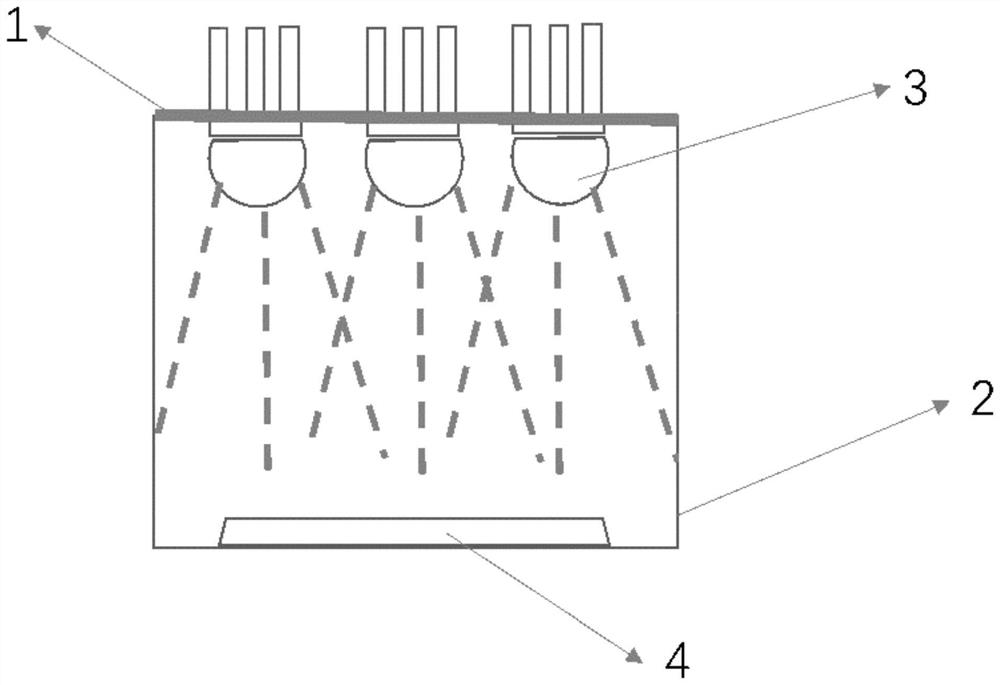Laboratory nucleic acid product removing method and device
A cleaning device and laboratory technology, applied in separation methods, chemical instruments and methods, gas treatment, etc., can solve problems such as cumbersome operation, experimental failure, and weak elimination effect, and achieve improved light conversion rate, improved removal effect, and high The effect of clearance
- Summary
- Abstract
- Description
- Claims
- Application Information
AI Technical Summary
Problems solved by technology
Method used
Image
Examples
Embodiment 1
[0022] Refer to attached figure 1 , this embodiment provides a laboratory nucleic acid product removal device, which is applied to a biological detection laboratory, and is used to reduce and eliminate aerosol pollution caused by nucleic acid and products, as well as related substances, and improve the effectiveness of laboratory test results , avoid the detection of false positive samples, and improve the continuous detection ability of the laboratory.
[0023] The device described in this embodiment includes an airtight chamber. The airtight compartment includes a detachably connected lamp bead illuminating board 1 and a compartment body 2 . When disinfecting samples, remove the lamp bead irradiation board 1, place the sample on the sample tray 4 in the chamber body 2, and then cover the lamp bead irradiation board 1 back to the top of the chamber body 2, and the edge of the lamp bead irradiation board 1 is provided with The rubber material makes it airtightly connected wit...
Embodiment 2
[0057] The present embodiment provides the device described in embodiment one to the elimination experiment of aflatoxin B1 in rice, and experimental condition is as follows:
[0058] Select 5g of mold-contaminated rice, and its aflatoxin B1 content is determined to be 30ug / kg. Spread the sample on the sample tray 4 and place it at the bottom of the airtight chamber. Select UVC lamp beads with a wavelength range of ultraviolet rays of 260-270nm and a center wavelength of 265nm. The optical power of the UVC lamp bead assembly is 13W. On the lamp bead irradiation board 1, turn on the UVC lamp bead assembly, irradiate the samples for disinfection, the irradiation distance is 5cm, collect the samples at three time points with irradiation time of 2, 5, and 10 seconds respectively, and the samples collected at each time point Sample utilizes liquid chromatography mass spectrometry to detect aflatoxin B1, and detection result is respectively 3ug / kg, 0.1ug / kg and undetected (detection...
Embodiment 3
[0060] This embodiment provides the device described in Embodiment 1 to eliminate the PCR aerosol experiment, and the experimental conditions are as follows:
[0061] Select the PCR amplification product with a concentration of 1ug / ml, place the sample collection tube at the bottom of the airtight chamber, and create an aerosol pollution model in the airtight chamber through a nebulizer. The wavelength range of ultraviolet rays is 260-270nm, and the central wavelength is 265nm UVC lamp beads, the optical power of the UVC lamp bead assembly is 13W, fixed on the lamp bead irradiation board 1, turn on the UVC lamp bead assembly, irradiate the sample to disinfect, the irradiation distance is 5cm, and the irradiation time is respectively collected. 2, 5, and 10 seconds for the samples at three time points, the CT values of the samples collected at each time point detected by fluorescent quantitative PCR were 30.1, 33.3 and 39.4 (20.5 for the non-irradiated control sample), indicatin...
PUM
 Login to View More
Login to View More Abstract
Description
Claims
Application Information
 Login to View More
Login to View More - R&D
- Intellectual Property
- Life Sciences
- Materials
- Tech Scout
- Unparalleled Data Quality
- Higher Quality Content
- 60% Fewer Hallucinations
Browse by: Latest US Patents, China's latest patents, Technical Efficacy Thesaurus, Application Domain, Technology Topic, Popular Technical Reports.
© 2025 PatSnap. All rights reserved.Legal|Privacy policy|Modern Slavery Act Transparency Statement|Sitemap|About US| Contact US: help@patsnap.com



